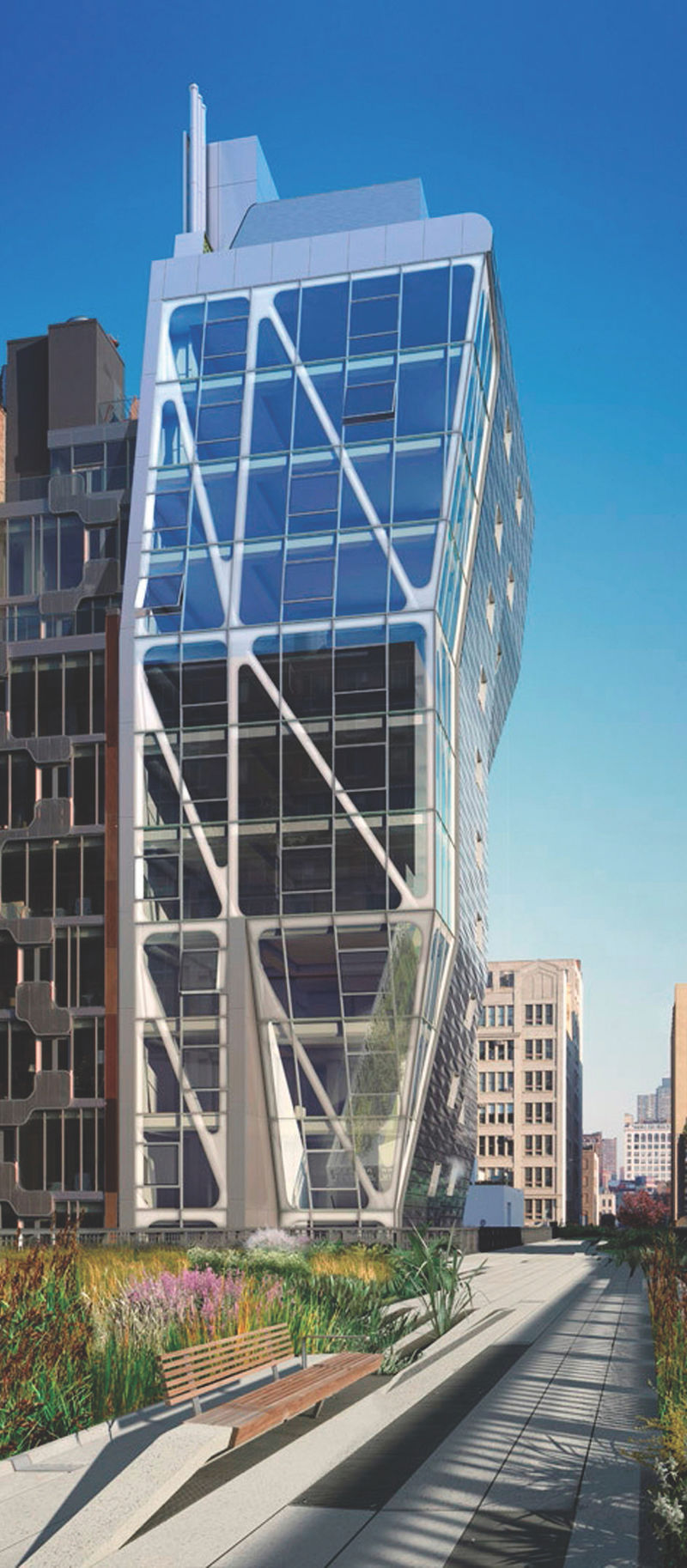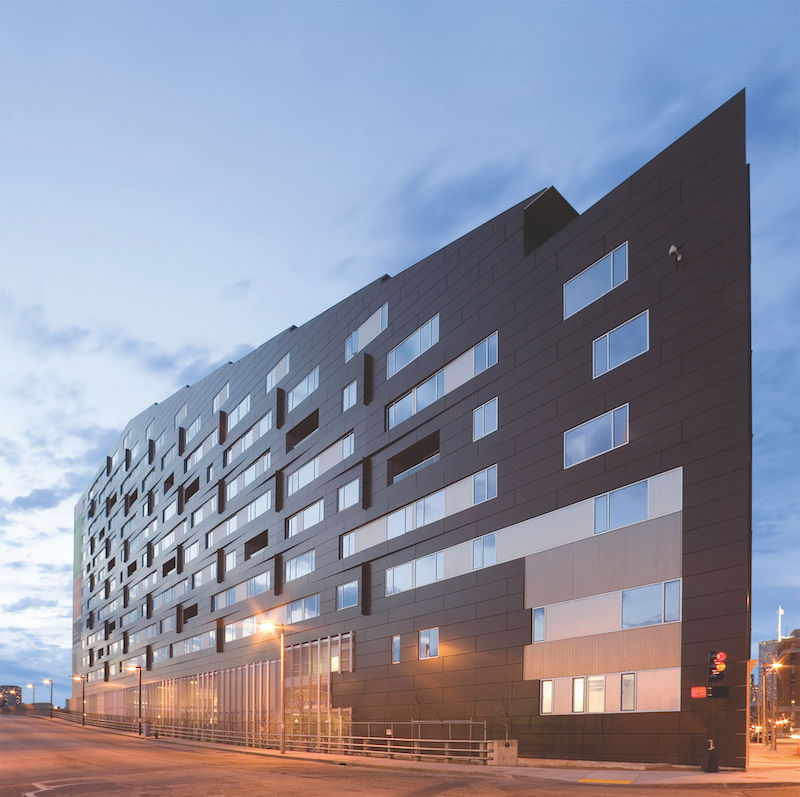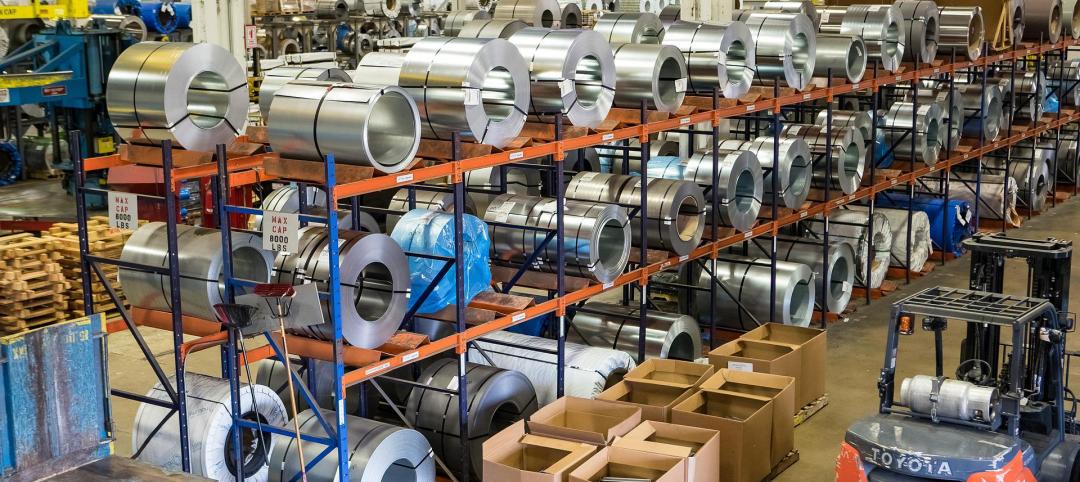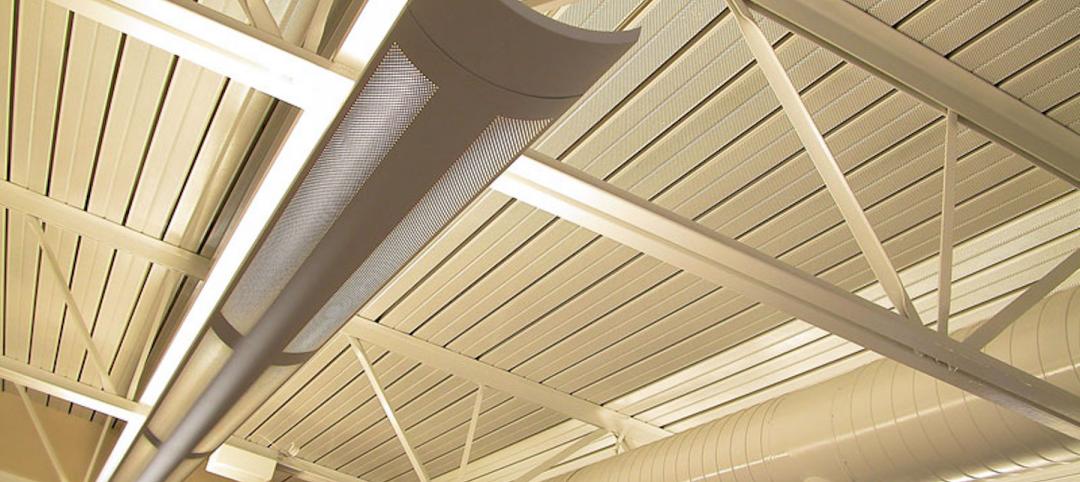Thanks to a number of key innovations, steel is playing a greater role in residential high-rises, senior and student housing, and taller mixed-use developments, says architect Jayshree Shah, AIA, NCARB, LEED AP BD+C, with the American Institute of Steel Construction (AISC). Michael Johnson, AIA, Founder/Design Principal at Carrier Johnson + Culture, says new structural approaches using steel have reduced floor-to-floor heights, getting closer to concrete slab thicknesses of 8–8½ inches. This allows more hospitality and residential buildings to take advantage of steel construction.
LEARNING OBJECTIVES
After reading this article, you should be able to:
+EXPLAIN how steel structural systems have been employed for use in multifamily residential structures, senior and student housing, and mixed-use developments.
+COMPARE steel-based thin-floor systems and long-span composite decks with traditional poured concrete structures for multifamily and multistory construction.
+LIST the benefits of BIM, steelXML and 3D visual collaboration tools in sustainable steel construction.
+DESCRIBE the use of staggered-truss arrangements, panelized load-bearing steel assemblies, and architecturally exposed structural steel.
One new structural approach is a hybrid, in which poured-in-place concrete cores provide lateral resistance, while the rest of the structure is built with structural steel. “A number of projects have switched to steel frames and precast plank floors, where the planks sit on the bottom flange of the beams,” says Tom Schultz, AIA, NCARB, Senior Project Manager, The Architectural Team.
This can reduce the depth of the floor-ceiling assembly and, in some cases, reduce floor-to-floor heights, he says. Most such systems rely on proprietary steel beam shapes requiring shorter column spacing. Schultz recommends them for residential and hotel use, but not necessarily for office or medical buildings.
Steel also has certain advantageous traits in terms of economics and sustainability, says Michael E. Liu, AIA, NCARB, Vice President/Principal, The Architectural Team. “While concrete requires approximately half the embodied energy of steel, it doesn’t offer steel’s recyclability,” he says. “A concrete structure will weigh much more than a steel equivalent, increasing foundation costs and, in some cases, requiring the implementation of piles, caissons, mat-slab, or other deep foundations, which suddenly make for an unfavorable embodied-energy equation.”
Dan Kaplan, FAIA, LEED AP, Senior Partner at FXFOWLE, says that for certain residential high-rise projects, “the motivation to use steel systems generally increases with the longer spans and complex, mixed-use conditions presented by such projects.”
For the Manhattan condominium tower 35XV, which has a school at its base, the design required a cantilever and longer spans for the school’s basketball court and other large rooms. “Steel increased the length of the spans, reduced the number of columns, and offered shallower depths of construction for the school and amenity floors,” says Kaplan.
 The Harman Group (SE) combined load-bearing steel wall panels with composite joist floors. This added eight stories and 68,000 sf to the original five-story concrete frame footprint of 2040 Market Street, Philadelphia. Photo: Courtesy Integrity Wall.
The Harman Group (SE) combined load-bearing steel wall panels with composite joist floors. This added eight stories and 68,000 sf to the original five-story concrete frame footprint of 2040 Market Street, Philadelphia. Photo: Courtesy Integrity Wall.
Among the most notable new construction solutions offered by steel are:
- Thin-floor systems, such as precast hollow-core planks set on steel beams with grout fill; the plank’s bottom surface is often used as an exposed or finished ceiling.
- Long-span composite decks, another economical floor-and-ceiling solution that offers sound control, using a steel floor deck as a permanent concrete form.
- In-wall beams, a framing system in which the girders are aligned to fall along interior partition lines, serving to support the walls; often used in conjunction with a thin-floor system.
- Steel-plate shear walls, a lateral force–resisting system for earthquake-resistant design; offers fast construction and lighter and thinner assemblies than reinforced concrete shear walls.
- Staggered-truss assemblies, useful in multistory and high-rise construction; story-high trusses can span two rows of exterior columns, producing large column-free areas for concourses, pools, auditoriums, and ballrooms.
- Braced-frame systems, similar to truss designs; its members, such as diagonal spans, work in both tension and compression to resist wind and seismic forces.
SLIMMING WITH THIN-FLOOR FLATS
The Architectural Team’s Schultz notes that combination steel frame and concrete plank floors are increasingly being used for residential and hospitality projects of five or six stories and higher. The systems are called “thin-floor” types because the slab floors can be as little as 10 inches in depth.
The lightweight, proprietary structural system used in the 28-story City Point Tower One, Brooklyn, N.Y., consists of an open-web interior steel girder and precast prestressed hollow-core slabs connected by cementitious grout. The 225,000-sf apartment building has 10-inch-thick precast hollow-core slabs providing low floor-to-floor heights with a noncombustible assembly and a smooth form finish for ready-made ceilings. It was designed by SLCE Architects and DeSimone Consulting Engineers (SE) and built by BFC Partners, with fabricator Breton Steel. Girder-Slab Technologies provided the steel–based framing system, which has been used in about 160 such buildings, according to Girder-Slab’s Dan Fisher, Jr.
In downtown Winnipeg, Man., the 21-story Glasshouse Skylofts employ a composite deck and steel columns to yield a thin-floor system that requires no additional fireproofing. Designed by Stantec, the 580,000-sf, glass-wrapped luxury condominium building employs proprietary steel beams connected to columns using modular corbels. The corbels were factory-welded to the steel columns to ease installation and create visually appealing beam-column connections. The system reduced the structural depth of each floor by 16 inches, allowing the developer, Urban Capital, to gain two more floors—and 199 more units—than would have been possible with conventional structural technology.
Thin-floor systems help eliminate formwork and concrete equipment from the project site, says AISC’s Shah. Such systems sometimes obviate the need for fire protection on the steel beams. Project teams can often erect more than one floor per day.
 High Line 23 overhangs New York’s now famous linear park. The designers used in-wall steel beams to maximize usable floor area in the 14-story condo building. Photo: Courtesy Neil M. Denari Arcthiects.
High Line 23 overhangs New York’s now famous linear park. The designers used in-wall steel beams to maximize usable floor area in the 14-story condo building. Photo: Courtesy Neil M. Denari Arcthiects.
CONVENTIONAL STEEL, LONGER SPANS
Long-span composite decks offer an opportunity to design with fewer columns or intermediate framing. They can extend up to 35 feet, with floor depths of 10–12 inches. During construction the metal deck doubles as formwork for the poured-in-place concrete, which also serves effectively as fireproofing. Once installed, the decks meet exacting criteria for impact isolation, floor vibration, and acoustics, which are essential for residential projects. Prefabricated deck sections can also speed erection. These assemblies can accept gypsum board for the ceiling finish. They weigh less than equivalent concrete structures.
NEW FIRE RATING IN THE WORKS
New directions in hybrid designs and fire protection for multistory steel structures, including steel-timber systems, have been the focus of work at the American Institute of Steel Construction. AISC President Charles Carter says the institute has been working with Underwriters Laboratories on a generic rating applicable to fireproofing of steel construction. Under most conditions, the fire-resistance ratings in UL D982 will reduce the thickness of the fire-protection application by as much as half.
This generic rating would take the place of the long-used distinction between restrained and unrestrained conditions—i.e., whether or not the thermal expansion of steel floors and beams is resisted (restrained) by the steel frame. New testing has shown that the distinction is not critical—and not only because all typical steel construction is considered tight and therefore restrained. In fact, tests of unrestrained floor assemblies showed that they produced results comparable to the performance of a similar floor in a restrained test.
This finding has meant that the thickness of the fire protection can be consistent in all these applications, per UL D982, thus reducing its thickness in many situations.
New research may open the door for more steel hybrids and composites. AISC is collaborating with Skidmore, Owings & Merrill on a test design combining a wood-panel structural floor with a steel frame. If successful, it would make steel more viable for multistory projects, especially for its span advantages, reduction of floor system weight, and seismic attributes.
The new hybrid design mixes steel beams and steel columns with cross-laminated timber (CLT) for floor construction in multifamily high-rises. The resulting system would compete with the reinforced concrete flat-plate systems using asymmetric steel beams that currently dominate the high-rise residential market.
The prototype system, which modifies a design using a concrete slab to accept the CLT floor panel assemblies, is currently in the concept phase. This will be followed by a testing phase to demonstrate its performance characteristics. “The panels require a lot of research,” says Carter. “The goal is to have the panels themselves exposed, which is not permitted in the codes now.”
Another goal is weight reduction. The panels weigh about one-third of typical hollow-core planks but can span just as far. The approach would also eliminate the need for shoring and reduce the potential for long-term deflection.
Long-span composite decks can achieve bays of up to 1,200 sf and clear spans of up to 36 feet, says Martin R. Williams, Design Development Manager, New Millennium Building Systems. The low profile of the systems sometimes allows for higher ceilings and more stories. Column footprints may be reduced to half the size of equivalent reinforced-concrete columns, eking out another 2% more floor area.
These benefits were important to architect ODA and developers Adam America Real Estate, The Naveh Shuster Group, and The Horizon Group, who built the 12-story condominium building 100 Norfolk Street, in New York City. The extended floor plates, made with lightweight framing, add usable area to the residences without markedly adding to foundation costs or the number of columns. The floor decks have a low profile, which creates the illusion of glass-only façades while maximizing ceiling heights. The diagonal members of the braced framing used for lateral support read through the glass façades. “With these structural systems, you can effectively replicate the flat-plate concrete market, so the long-span steel products go toe-to-toe with precast,” says Williams.
Another technique, first developed by architect Jorge de Quesada and structural engineer Sunil Gupta, PhD, SE, of OLMM Consulting Engineers, has been applied to several multifamily buildings since its introduction in 1996. The lightweight steel construction system simplifies foundation assemblies required for poor soils. The shop-fabricated welded vertical frames, premade up to eight stories high, feature bent plates that support light-gauge floor panels; once in place, they are usually topped with a thin layer of concrete.
“This prefab ladder frame with joists and composite decks is a useful solution for high seismic areas and buildings typically of four to eight stories, but it can go taller, with maximum spans of 24 feet,” says AISC’s Shah. Recent projects using the system include four stories of live-work lofts at 1221 Harrison Street and seven stories of luxury condominiums at 1840 Washington Street, both in San Francisco.
STAGGERING IMPROVEMENTS
Reducing the need for interior columns is another benefit steel provides for construction speed, simplicity, and optimized floor area. The staggered-truss approach offers a tried-and-true advantage for multistory hotels, residences, and dormitories. Developed almost 50 years ago, staggered-truss structures employ full-span, story-high trusses that are staggered every other column line. This zigzags the lateral loads and allows structures up to 30 floors in height to efficiently handle both lateral and vertical loads; above that height, exterior shear walls, moment frames, or braced-frame cores can be deployed to handle greater lateral loads.
One recent staggered-truss project is the Macallen Building Condominiums, South Boston, Mass., a 140-unit block with exterior fins marking the truss locations. Designed by Office DA and led by Stantec Architecture, the building has won awards for its novel form.
Another efficient approach that is often paired with a long span composite deck is the in-wall beam system, so called because the steel girders align with demising walls or corridor partitions (or both), often with the concrete plank spanning the width of the residential units or hotel rooms. The structural floor depth is only eight inches, and all the interior girders are enclosed within the corridor walls, says AISC’s Shah. The in-wall beam concept allows for low floor-to-floor heights and fast erection.
Among the high-profile projects utilizing in-wall beams are a six-story residence hall for DePaul University, Chicago, and the 14-story High Line 23 in New York City, the latter designed by Neil M. Denari Architects and Marc Rosenbaum Architects with DeSimone Consulting Engineers (SE) and T. G. Nickel & Associates (GC) for developer Alf Naman. The “slim-fit” tower, with one condominium per floor, tapers dramatically outward. The design concept uses the in-wall beams to maximize usable floor area and eke out an extra floor in the permissible zoning envelope.
Another novel structural approach can be found in chassis-based modular building systems, which reduce steel systems to frames comprising wide-flange beams, concrete-filled box columns, or hollow structural section (HSS) columns, along with proprietary gravity connectors and ordinary moment frame (OMF) or special moment frame (SMF) connectors. (Note: OMFs are considered more suitable for low seismic regions; SMFs are preferred for higher seismic zones.)
These modular kits employ BIM tools, robotics, and CNC machining technologies. “They can be two to five times faster to erect than conventional steel structures, and they require no shear walls or braces, making them a very clean and simple framing system,” says Kelly Luttrell, Co-founder/Vice President, ConXTech, a turnkey structural system provider. “The systems allow you to lay out walls and windows wherever you like, and go higher than wood framing without incurring the extra costs of concrete.”
A modular chassis system was used in the 700-unit luxury complex Eighth and Grand in downtown Los Angeles, designed by Carrier Johnson + Culture and Daryoush Safai Architects for Carmel Partners. “While the applications can be limited to a certain height, the benefits of the prefab steel system are ideal for this large floor plate and high-density occupancy,” says Carrier Johnson’s Michael Johnson. Its bolted connections are durable and seismically resistant. The system is certified Cradle to Cradle Silver.
 Macallen Building Condos 2, South Boston, Mass., used a staggered-truss configuration (inset, courtesy AISC). The 140-unit block, designed by Office DA and Stantec Architecture, has studio, 1BR, and 2BR rentals and condos. Photo: Courtesy Stantec Architects.
Macallen Building Condos 2, South Boston, Mass., used a staggered-truss configuration (inset, courtesy AISC). The 140-unit block, designed by Office DA and Stantec Architecture, has studio, 1BR, and 2BR rentals and condos. Photo: Courtesy Stantec Architects.
EFFICIENT TO THE CORE
Gensler (architect) and Nabih Youssef & Associates (SE) put a new twist on conventional steel framing in the 56-story Hotel and Residences at L.A. Live. They employed steel-plate shear walls rather than traditional concrete shear walls. This added usable square footage to the interior and obviated the need for perimeter moment frames, which would have blocked views from the tower.
STEEL, BIM, and 3D VISUALIZATION
A number of improvements in digital fabrication, fire resistance, and environmental accountability are offering new reasons to consider steel. Chief among these is BIM. The steel industry was a leader in the use of BIM, primarily for steel system detailing and fabrication. Building Teams are seeing more models being used, says Luke Faulkner, AISC’s Director of Technology Integration. Models are going directly from detailers to fabricators. One such fabricator is Ficep, Forest Hill, Md.
Building Teams are also using 3D visual collaboration tools, which take “exported” BIM models and make them easier and faster to access. Software like Revizto enables general contractors and steel subcontractors to review BIM files from engineers and architects. Such programs enable GCs and steel contractors to view and navigate through the 3D replicas of their projects to find key information on materials and methods. These gaming-style environments streamline the BIM data and make it easier for all construction team members to use it.
Another advance is steelXML, a platform for bringing e-commerce to the steel industry and streamlining the procurement process. AISC has assembled a working group of mills, service centers, fabricators, and software vendors to figure out how to standardize the transaction process. Georgia Institute of Technology is handling the technical development of this scheme.
AISC has also developed environmental product declarations, based on data submitted by 286 fabricators. Two of three new EPDs have been released (see http://bit.ly/29Vvvbb); a third will be published later this year. Taken together, the EPDs will provide standard formatted information on the environmental benefits and impacts of any steel produced in North America.
“This approach can offer big schedule advantages, similar to the use of steel plates for core construction rather than the typical concrete core design,” says AISC’s newly named President, Charles J. Carter, PE, SE, PhD. For L.A. Live, which has more than a thousand hotel rooms and 224 luxury residential units, the use of steel-plate shear walls is credited with cutting the construction budget by millions and accelerating completion by several months.
Yet another steel system combines panelized load-bearing assemblies with open-web steel joists and composite decks. Some of these use HSS tubing rather than conventional cold-formed steel (CFS) framing to provide load-bearing steel wall panel systems for buildings up to 10 stories, says Fred Hartmann, President, South Shore Iron Works, Chicago, an AISC-certified wall panel fabricator. The load-bearing walls allow for longer spans. When used with open-web steel joists and composite decks, they can be exceptionally durable. They can also be combined with gypsum board to provide up to a four-hour fire rating.
Recently, developer PMC Property Group employed load-bearing panels to expand 2040 Market Street, Philadelphia, from a five-story headquarters office building to include eight new stories of residences and new ground-floor retail space. On top of the existing concrete frame, the structural engineers at The Harman Group designed a combination of load-bearing steel wall panels with a composite joist floor system. The scheme added 120,000 sf above the eight new floors and 68,000 sf of horizontal floor area to the original footprint.
Other building projects are taking advantage of the efficiency and aesthetics of architecturally exposed structural steel (AESS). (See BDCuniversity course: http://bit.ly/29uaUYy.) According to Roger E. Ferch, PE, AISC’s Immediate Past President, use of architecturally exposed steel in buildings is on the rise. He cautions that the exposed steel must be correctly specified to achieve the right appearance, and materials and labor must be properly budgeting for.
Done properly, AESS is worth the investment. “We spent a lot of time on creative ways to expose steel for the New York Times Building,” says FXFOWLE’s Kaplan, whose firm worked under designer Renzo Piano Building Workshop on the 2007 project. “Today, we’re seeing more and more use of intumescent paint and other approaches, which allow building designs to celebrate the beauty of the structure.”
In general, says Kaplan, the thicker the steel member, the thinner the coating needed, because steel has inherent fire resistance that increases with the size of the steel member.
For older buildings, renovations and adaptive-reuse project teams may choose to expose steel and cast-iron elements for their decorative value, says The Architectural Team’s Liu. Kaplan says these elements can add distinction to otherwise anonymous buildings. “For one nondescript prewar building, the newly exposed steel and cast iron in the lobby helped give it a sense of history, authenticity, and rootedness,” he says.
Related Stories
Building Materials | Nov 2, 2022
Design for Freedom: Ending slavery and child labor in the global building materials sector
Sharon Prince, Founder and CEO of Grace Farms and Design for Freedom, discusses DFF's report on slavery and enforced child labor in building products and materials.
Building Materials | Aug 3, 2022
Shawmut CEO Les Hiscoe on coping with a shaky supply chain in construction
BD+C's John Caulfield interviews Les Hiscoe, CEO of Shawmut Design and Construction, about how his firm keeps projects on schedule and budget in the face of shortages, delays, and price volatility.
Building Materials | Jun 20, 2022
Early-stage procurement: The next evolution of the construction supply chain
Austin Commercial’s Jason Earnhardt explains why supply chain issues for the construction industry are not going to go away and how developers and owners can get ahead of project roadblocks.
Sponsored | BD+C University Course | May 10, 2022
Designing smarter places of learning
This course explains the how structural steel building systems are suited to construction of education facilities.
Sponsored | BD+C University Course | Apr 19, 2022
Multi-story building systems and selection criteria
This course outlines the attributes, functions, benefits, limits, and acoustic qualities of composite deck slabs. It reviews the three primary types of composite systems that represent the full range of long-span composite floor systems and examines the criteria for their selection, design, and engineering.
Contractors | Mar 28, 2022
Amid supply chain woes, building teams employ extreme procurement measures
Project teams are looking to eliminate much of the guesswork around product availability and price inflation by employing early bulk-purchasing measures for entire building projects.
Sponsored | BD+C University Course | Jan 30, 2022
Optimized steel deck design
This course provides an overview of structural steel deck design and the ways to improve building performance and to reduce total-project costs.
Sponsored | Steel Buildings | Jan 25, 2022
Structural Game Changer: Winning solution for curved-wall gymnasium design
Sponsored | Steel Buildings | Jan 25, 2022
Multifamily + Hospitality: Benefits of building in long-span composite floor systems
Long-span composite floor systems provide unique advantages in the construction of multi-family and hospitality facilities. This introductory course explains what composite deck is, how it works, what typical composite deck profiles look like and provides guidelines for using composite floor systems. This is a nano unit course.
Sponsored | BD+C University Course | Jan 12, 2022
Total steel project performance
This instructor-led video course discusses actual project scenarios where collaborative steel joist and deck design have reduced total-project costs. In an era when incomplete structural drawings are a growing concern for our industry, the course reveals hidden costs and risks that can be avoided.

















